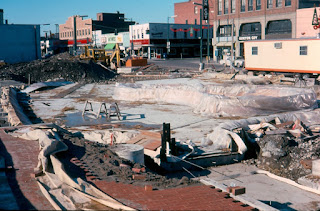It
takes less than ten minutes to take a leisurely stroll from one end of the Mark
Twain Riverfront Park in Elmira to the other, but there is a lot of history in the
six-acre green space. The passive park is a strip of green running from Main
Street to Lake Street between Water Street and the Chemung River.
 |
| Google Maps view of the Mark Twain Riverfront Park |
 |
| Rear of the buildings on Water Street showing flood damage, 1972 |
 |
| Dedication of Mark Twain Riverfront Park, 1976 |
The Fountain
 |
| Fountain dyed pink in support of the Susan G. Komen Race for the Cure held in the middle of May 2019 |
Erie Viaduct
Next
we come to the Erie Viaduct. While this is not technically one of the park’s
features, it does run through it. The builders of the park in the 1970s had to
work around this significant structure that was opened in 1934. The $3.2
million project eliminated at grade railroad lines that had cut the city in
half.
Clemens Center Parkway
The
next structure we come to on our tour is the Clemens Center Parkway. Just three
years after the park opened, the new north-south arterial, another piece of the
“New Elmira” plan, cut it nearly in half. In 1979, the entire length of Phase 1
of the arterial, from Pennsylvania Avenue to East Washington Avenue opened to
traffic. The name Clemens Center Parkway was chosen because the Clemens Center
was one of the most successful projects of “New Elmira,” attracting thousands
of people from near and far into downtown.
Just
on the east side of the Clemens Center Parkway, we find a historic marker for
the Chemung Canal. The canal opened in 1833, running from Seneca Lake to the
Chemung River, and this was where it connected to the river. In 1878 the canal was
abandoned in favor of railroads, which were cheaper, faster, and offered
year-round service.
Sailplane Sculpture
Citizens & Northern Bank Building
As
we continue our virtual walk through the park, we come upon the Citizens &
Northern Bank. The building was constructed in 1976 on a plot of land acquired
through the Department of Housing and Urban Development, not as part of the
Open Space grant that funded the rest of the park because that grant
specifically prohibited commercial development. Shepard’s Sirloin Room, run by
Morris W. Shepard Jr., opened for business in early 1977 and operated for
thirteen years. In 1991, DeFilippo Brothers, Attorneys at Law, moved into the
building. When the firm relocated in 2017, Citizens & Northern Bank purchased
the building and opened a loan production office there.
After
walking past the bank, we come upon one of the most recognized and most
troublesome features of Mark Twain Riverfront Park, the Citizens Cascade
Fountain. The sculptural, 35-foot-tall, multi-tiered fountain made of cut
granite was dedicated on August 9, 1977 with a crowd of about 100 in
attendance. A plaque near the fountain reads: Citizens Cascade. Created to honor the people of Elmira for their
spirit and determination to restore and beautify the Queen City after the
devastating flood of June 23, 1972. “This is our home town and nothing under
God will take it from us.”
 |
| Dedication of the Citizens Cascade Fountain, August 9, 1977 |
Russell F. Gee Jr. Plaque
 |
| Stone with a plaque that reads: Russell F. Gee Jr.: a community builder |
In
1975, as plans were being made for the creation of Mark Twain Riverfront Park,
the Elmira City Council changed a resolution calling for the new park to
stretch the entire length of Water Street from Main Street to Lake Street in
order to preserve this mini-park. So, this virtual walking tour has, in fact,
been through two parks.










Thanks for the tour. Can't wait to walk it ourselves.
ReplyDelete